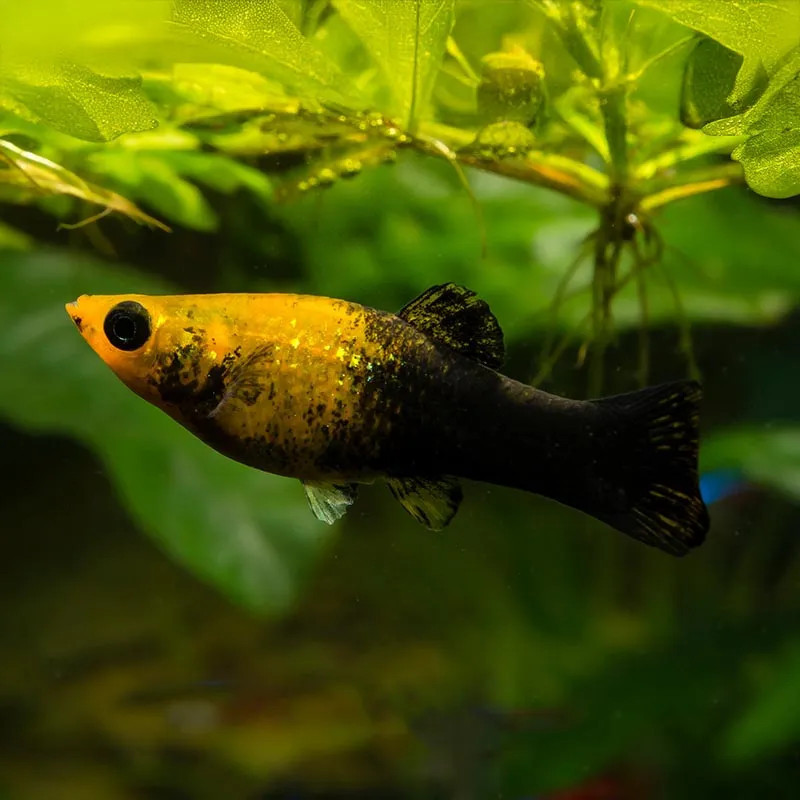Stocks Available
Assorted Molly - XL
SKU:105841
POECILIA LATIPINNA
XL

Stock Available
Introduction: • Species: Gold Dust Molly • Common Names: Gold Dust Molly, Gold Dust Lyretail • Natural Habitat: Inhabits freshwater and brackish waters, often found in lagoons, estuaries, and rivers throughout the southern United States and parts of Central America. Physical Characteristics: • Appearance: Features a vibrant golden-yellow body adorned with striking speckled patterns, especially prominent on the fins. Males often display a lyretail fin that is elegantly forked. • Size: Typically reaches lengths of about 3-4 inches (7-10 cm). • Lifespan: Generally lives for 3-5 years when provided with proper care and suitable tank conditions. Habitat Requirements: • Tank Size: A minimum of 20 gallons is recommended for a small group; larger tanks are preferable for community setups. • Water Conditions: o Temperature: Prefers water temperatures ranging from 72-82°F (22-28°C). o pH: Thrives in a pH range of 7.0-8.0. • Aquascaping: Provide a well-planted tank with plenty of swimming space and hiding spots using driftwood and rocks to mimic their natural habitat. Diet: • Primary Diet: Omnivorous; in the wild, feeds on algae, plant matter, and small invertebrates. • Supplemental Feeding: In captivity, offer a balanced diet of high-quality flake or pellet foods, supplemented with live or frozen foods such as brine shrimp and bloodworms. • Feeding Frequency: Feed small amounts 1-2 times daily to ensure a varied diet and prevent overfeeding. Compatibility: • Temperament: Generally peaceful and sociable, making them suitable for community tanks. • Suitable Tank Mates: Pairs well with other peaceful species such as guppies, tetras, and various mollies. • Incompatibilities: Avoid housing with aggressive species that may harass or stress the Gold Dust Molly. Care Level: • Difficulty: Easy to care for, making them ideal for beginners and experienced aquarists alike. • Health Monitoring: Regularly check for signs of stress or disease, including common ailments like fin rot and ich. Breeding: • Breeding in Captivity: Can be easily bred; they are livebearers and give birth to free-swimming fry. • Spawning: Males engage in courtship displays, and females can produce multiple batches of fry throughout the year. Economic Considerations: • Market Demand: Highly sought after due to their attractive appearance and adaptability to various tank conditions. • Wholesale/Retail Pricing: Generally affordable, readily available in pet shops and online. Sustainability and Conservation: • Wild Population: Generally stable, but habitat loss and pollution can pose risks to local populations. • Aquaculture Efforts: Frequently bred in captivity to meet market demand and reduce reliance on wild stocks. • Regulations: Compliance with local and international regulations regarding the trade of freshwater species is essential. Conclusion: The Gold Dust Molly is a beautiful and lively addition to freshwater aquariums, admired for its stunning coloration and friendly disposition. Its ease of care and compatibility with various tank mates make it an excellent choice for both novice and experienced aquarists. With proper attention to its environment and diet, the Gold Dust Molly can thrive, offering both aesthetic appeal and enjoyment in any aquatic setting.
Data sheet
15 other products in the same category: